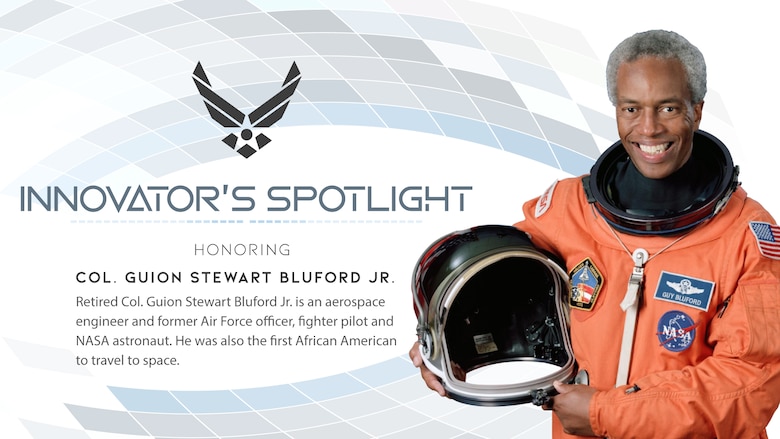Diversity and inclusion are warfighting and innovation imperatives. A drumbeat that spotlights diverse thinking and contributions of diverse Americans to air and space power is a critical component to demonstrating that the Department of the Air Force values its diversity to achieve mission success. One of those innovators to contribute to mission success is Dr. Guion S. "Guy" Bluford.
A quiet boy who dreamed of reaching the stars, Bluford did indeed reach his dreams by simply doing things he enjoyed and being persistent in doing them. It was just also enough to be the first African American in space.
Bluford was born in Philadelphia in the 1940s; his mother was a school teacher, and his father was a mechanical engineer. He lived in a middle-class neighborhood and was interested in airplanes. It was in high school he decided he wanted to be an aerospace engineer.
Education was important in Bluford's family ― his parents and grandparents went to college. Knowing that he eventually wanted to be an engineer, he had to go; living with the third generation of people who attended college, he was expected to go.
Thanks to his parents allowing him to be what he wanted to be and the strong bond they had for each other, Bluford was propped up by deeply-rooted and strong family values and somewhat sheltered from events such as the civil rights movement and segregation African Americans had to deal with in the '40s and '50s.
From high school, Bluford entered the aerospace engineering program at Penn State University in 1964 through the then-mandatory ROTC program. Civil rights and the Vietnam War were major issues during his college career and ultimately would lead him to join the Air Force to continue his affinity for aircraft and flight. Upon receiving his commission, Bluford attended pilot training at Williams Air Force Base, Arizona, earning his wings in 1966. From there, Bluford, now a pilot, would ship off to war, joining the 557th Tactical Fighter Squadron, Cam Ranh Bay, Vietnam. He would fly more than 140 combat missions in the Vietnam War while logging more than 5,200 hours in various aircraft, including the F-15 Eagle, F-4C Phantom II, U-2, F-5A, and training aircraft T-33, T-37 and T-38 Talon.
After Vietnam, the decorated aviator would return to the United States at Sheppard AFB, Texas, serving in various positions, including instructor pilot, standardization/evaluation officer and executive officer. He would also return to school, where he earned his master's degree and a doctorate in aerospace engineering from the Air Force Institute of Technology at Wright-Patterson AFB, Ohio. He was assigned to the Air Force Flight Dynamics Laboratory from 1972 to 1974, eventually applying for the astronaut corps in 1977. Of approximately 8,000 applicants, Bluford was one of 35 selected, including two other African Americans, Dr. Ronald McNair and Lt. Col. Fredrick Gregory, and six women, including Sally Ride. At the age of 37, Bluford became an astronaut. He and his fellow innovators would be among the first to fly in today's space shuttle.
In the '50s and '60s, job opportunities were limited for women and minorities. They were often segregated in care-oriented fields or jobs in the beauty industry, social work, nursing and secretarial work. NASA astronauts were selected from mostly white male test pilots. Once NASA began including scientists, medical doctors and engineers in the selection process, a door opened for a more diverse corps of astronauts that included minorities and women. Bluford would be the first African American in space and would become one of the new faces of NASA as it is known today.
Throughout his space career, Bluford left Earth four times, logging more than 700 hours in orbit on the space shuttles Discovery and Challenger. His first flight was Aug. 30, 1983, the first time a Black man went into space. It was a momentous day for Bluford, NASA and America, and it was a momentous day for race relations and a step in the right direction of equality.
Joining the crew of STS-8 as a mission specialist on that historic day in 1983, the engineer-turned-astronaut's job was to run the mechanical arm, deploy communications satellites and perform biomedical experiments, including taking medical measurements to better understand the biopsychological effects of space flight. Bluford helped develop guidelines for nighttime landings and launches, further innovating the space program. He performed a variety of scientific tasks on the three other missions he flew.
In 1983, Bulford left the astronaut corps to work in the aerospace industry, eventually founding an engineering consulting organization and holding many leadership positions. During an interview with NASA, Bluford, a member of the International Space Hall of Fame, said, "I was very proud to have served in the astronaut program and to have participated on four very successful space shuttle flights. I also felt very privileged to have been a role model for many youngsters, including African American kids, who aspire to be scientists, engineers and astronauts in this country. For me, being a NASA astronaut was a great experience that I will always cherish."

Retired Col. Guion Stewart Bluford Jr. is an aerospace engineer and former Air Force officer, fighter pilot and NASA astronaut. He was also the first African American to travel to space. (U.S. Air Force graphic by Alfredo Tirado)






